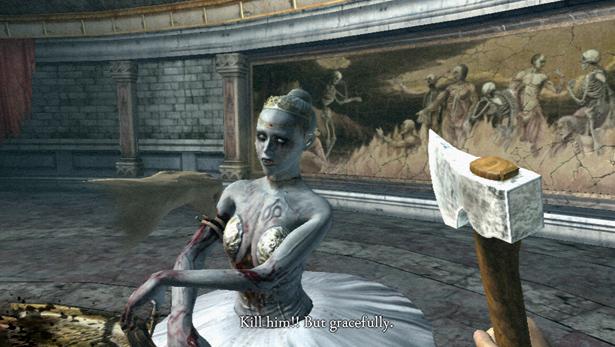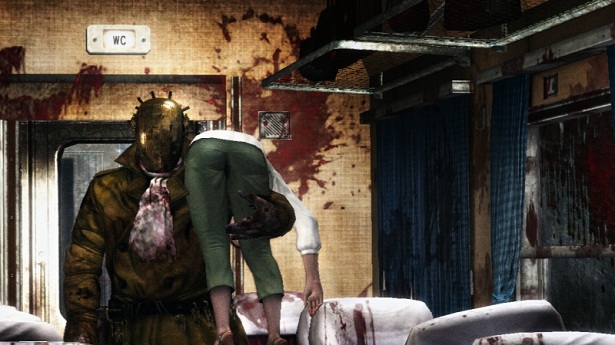
Remember in Mission Impossible 64 (you remember) when Ethan Hunt had to schmooze his way through the Russian Embassy to quietly incapacitate the Ambassador’s aide, assume his face, then talk his way into the KGB headquarters? Remember the slight nuances of the infamously convoluted Mission Impossible storyline, the significance of an understated Job 3:14, and remember how, for one brief mission, the intensity and illusion held taut and all was glorious in the 64-bit landscape?
Rise of Nightmares starts with similar promise, but replaces subtlety with a canned B-movie premise. (Hint: If you aren’t even interested in B-movies for their “unintentional” kitsch, save yourself some time and skip to the score.) For those of us with so cleft film palates that we prefer the unwatchable to the watchable, the introductory train ride through the Romanian countryside strikes a chord in what we still, stubbornly, call our brains.
My window into this poor man’s Resident Evil, Josh, contends with a drinking problem, a frustrated spouse, a train full of ne’er-do-wells, and stereotypical stereotypes (cheerleaders, Russian military, the gypsy fortune teller with ominous Tarot cards). The dialogue is as flimsy as the predictably lame attempt at character development. A mysterious stranger and some bloody cushions appear. Train crash, cave, zombies. The so-bad-it’s-good wheels are in full rotation.

An up until combat (there’s a bit in the prologue, but I’m ignoring that for now), the controller-less controls are… let’s say clumsy. A wide slide of the hand to open doors, crouching to crouch, one foot in front of the other for forward motion, inexact twist of the shoulders for turning. Walking serves up a greater challenge than any battle, but can be avoided altogether with an on-rails mode. The freedom of movement is ambitious for a Kinect title, to be sure, but it isn’t fully cooked. More time in the oven (it may be years yet) and the idea may prove a glorious revolution. For now, the heinously awkward movement controls are as low-rent as the storyline.
I didn’t play Rise of Nightmares to take a jagged stroll through a mad scientist’s endless compound, I played it (frankly, to review it, but also) for the combat. Enemies are zombies, in representation and AI. Bloody tussles with demented, slutty nurse zombies, and every other bipedal enemy for that matter, are a matter of timing and preparedness. Choose the cleaver, the ice saw (absolutely devastating, that), garden shears, or the fireballs (?) to accommodate the enemy. Some half-armor-clad fools will block uncharged weapons on one side, requiring a swing from the other. Bosses take longer but suffer from the same hoops. Slash, block, slash-slash, block. Wildly waving arms won’t do the trick. Thankfully, a modicum of skill is involved, though not much.
A few moments in House on Haunted Hill, I mean Rise of Nightmares, lurch towards the Kinect’s real potential for horror. A darkened hallway, and unexpected growl, the expected dialogue, “RUN!” And I have to run, else face the “You Are Dead” loading screen. As a lazier gamer, I tried less strenuous movement combinations to try and hack my way through running and was unsuccessful. It’s a good thing, I later realized, and not just for my sedentary ass. The effort required to run pushes the player into a kind of panic mode, faster heart rate, grit teeth, and (I’ll admit) slight perspiration. It’s the feeling of desperation and near powerlessness that games like Amnesia: The Dark Descent tap into so well and by such radically different means. As a reminder, this happened in a Kinect game. Kinect, people.
The vinegar strokes of motion control brilliance do not a good game make. Ninety-five percent of Rise of Nightmares is occupied by a campy narrative and even campier controls. It’s a ballsy lunge in the “right” direction for full-body motion controls, a genuinely gimmicky approach. The nuance of the B-movie writing (intentional, I pray) may delight fans of the weird and the worse, but will certainly repel erstwhile horror geeks. Years from now, when “Dead Space 7” or “Silent Hill 77” successfully wrangle motion controls for fights and frights, Rise of Nightmares may be remembered as a moment of genius genesis for the industry. Today, it’s bad. Good?

















